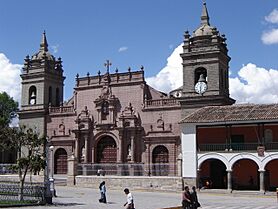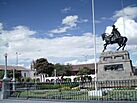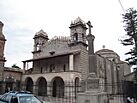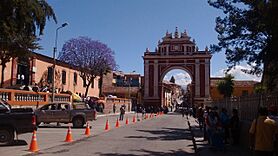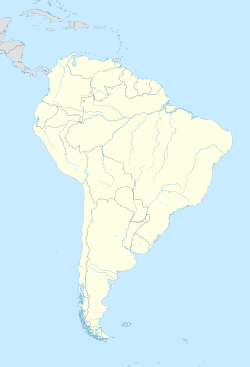Ayacucho facts for kids
Quick facts for kids
Ayacucho
Huamanga
San Juan de la Frontera de Huamanga
|
|||
|---|---|---|---|
|
Ayacucho Basilica Cathedral
Plaza de Armas de Ayacucho
Mirador Acuchinay Observatory
Templo de Santo Domingo de Guzmán
Mariscal Sucre Monument
Ayacucho Triumphal Arch
|
|||
|
|||
| Nickname(s):
The City of Churches
|
|||
| Country | Peru | ||
| Region | Ayacucho | ||
| Province | Huamanga | ||
| District | Ayacucho | ||
| Settled | April 25, 1540 | ||
| Area | |||
| • Total | 2,981.37 km2 (1,151.11 sq mi) | ||
| Elevation | 2,761 m (9,058 ft) | ||
| Population
(2015)
|
|||
| • Total | 180,766 | ||
| • Density | 60.63186/km2 (157.0358/sq mi) | ||
| Demonym(s) | Ayacuchano, -1 | ||
| Time zone | UTC-5 (PET) | ||
| • Summer (DST) | UTC-5 (PET) | ||
| Area code(s) | 66 | ||
| Website | http://www.munihuamanga.gob.pe/ | ||
Ayacucho is a city in Peru. It is the capital of the Ayacucho Region. The name Ayacucho comes from the Quechua words aya ("death" or "soul") and k'uchu ("corner"). This name honors the Battle of Ayacucho.
The city was founded in 1540. Its first name was San Juan de la Frontera de Huamanga. People often called it Huamanga. In 1825, Simón Bolívar changed the name to Ayacucho. This was to remember the important battle that helped Peru become independent.
Ayacucho is famous for its many churches. There are 33 churches, one for each year of Jesus' life. The city has big religious celebrations, especially during Holy Week before Easter. These events include horse races with Peruvian Caballos de Paso. There is also a traditional running of the bulls called jalatoro or pascuatoro. In jalatoro, horses lead the bulls, which is different from the Spanish encierro.
Contents
History of Ayacucho
Early Settlements and Ancient Cultures
People lived in the Ayacucho area over 15,000 years ago. Evidence of these early humans was found at Pikimachay. This site is about 25 kilometers north of Ayacucho.
From 500 to 900 AD, the Wari culture lived here. The Wari became the first big empire in the Andes mountains. They were powerful before the Inca Empire existed. The Wari capital city was near where Ayacucho is today.
After the Wari culture ended around 1000 AD, new groups formed. These groups were strong and warlike. They joined together in an alliance called the "Chanca confederacy".
Inca and Spanish Rule
The Inca Empire later conquered the Chanca confederacy. The Inca built important centers in the region. One was Vilcashuaman, a large Inca city. Another was Huamanga, which is now Ayacucho.
Spanish conqueror Francisco Pizarro founded Huamanga on April 25, 1540. He named it San Juan de la Frontera de Huamanga. There were many Inca rebellions against the Spanish. So, Pizarro quickly brought Spanish people from Lima and Cusco to live there.
In 1544, the city was given a special title. It was called La Muy Noble y Leal Ciudad de Huamanga. This meant "the most noble and loyal city of Huamanga". It was the highest honor a city could get from Spain. The main university, San Cristóbal of Huamanga University, started in 1677. Ayacucho was an important stop between Lima and Cusco.
Independence and Modern Times
On February 15, 1825, Simón Bolívar changed the city's name to Ayacucho. This was to honor the Battle of Ayacucho. The battle happened nearby on December 9, 1824. It was the final fight for Peru's independence from Spain.
The independent forces were led by Antonio José de Sucre. He was Simón Bolívar's trusted general. The victory at Ayacucho secured freedom for Peru and South America. People say the name "Ayacucho" came from seeing many fallen soldiers. Aya means "dead" and kuchu means "corner" in Quechua.
After independence, the city's economy faced challenges. A planned railway was not completed. However, a highway was built in 1968. Today, Ayacucho's economy relies on farming and small factories. They make things like textiles, pottery, and leather goods. It is also a popular place for tourists. People visit its 33 colonial churches and the battlefield of La Quinua. The University of San Cristóbal reopened in 1959.
In the 1980s, the region faced a period of unrest. A group called the Shining Path used Ayacucho as a base. This caused many people to leave the area. After their leader was captured in 1992, the unrest decreased. Ayacucho is a rural area and one of the poorer parts of Peru. People are now working hard to improve life and create jobs.
Notable people from Ayacucho
- María Parado de Bellido, heroine in War of Independence.
- Andrés Avelino Cáceres, President of Peru (1886–1890) and (1894–1895)
- Luis Guillermo Lumbreras, archaeologist.
- Alberto Arca Parró, economist and lawyer.
- Raúl García Zárate, guitarist.
- Renata Flores Rivera, singer
Climate
Ayacucho is high up in the mountains. Because of this, it has a cool climate. It gets a lot of rain during certain times of the year. This is like a monsoon season. The weather is generally mild, not too hot or too cold.
| Climate data for Ayacucho | |||||||||||||
|---|---|---|---|---|---|---|---|---|---|---|---|---|---|
| Month | Jan | Feb | Mar | Apr | May | Jun | Jul | Aug | Sep | Oct | Nov | Dec | Year |
| Mean daily maximum °C (°F) | 23.6 (74.5) |
23.5 (74.3) |
23.0 (73.4) |
23.8 (74.8) |
23.9 (75.0) |
23.2 (73.8) |
22.7 (72.9) |
23.6 (74.5) |
23.8 (74.8) |
24.9 (76.8) |
25.5 (77.9) |
24.6 (76.3) |
23.8 (74.9) |
| Mean daily minimum °C (°F) | 10.5 (50.9) |
10.5 (50.9) |
10.3 (50.5) |
9.7 (49.5) |
8.2 (46.8) |
7.1 (44.8) |
6.6 (43.9) |
7.7 (45.9) |
9.2 (48.6) |
10.1 (50.2) |
10.7 (51.3) |
10.7 (51.3) |
9.3 (48.7) |
| Average precipitation mm (inches) | 117.1 (4.61) |
101.5 (4.00) |
93.6 (3.69) |
23.8 (0.94) |
23.9 (0.94) |
23.2 (0.91) |
22.7 (0.89) |
23.6 (0.93) |
23.8 (0.94) |
24.9 (0.98) |
25.5 (1.00) |
24.6 (0.97) |
528.2 (20.8) |
| Source: National Meteorology and Hydrology Service of Peru | |||||||||||||
Images for kids
See also
 In Spanish: Ayacucho para niños
In Spanish: Ayacucho para niños


